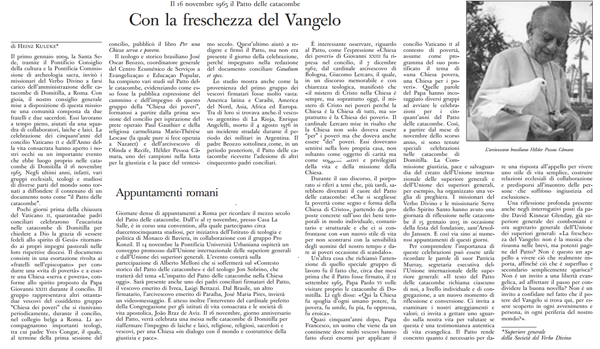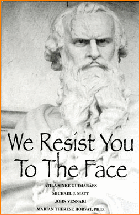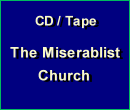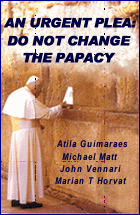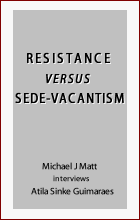Documents for your files
 |
PROGRESSIVIST DOCUMENT OF THE WEEK
L'Osservatore Romano praises
the Pact of the Catacombs
the Pact of the Catacombs
As the miserablist line of Pope Francis' pontificate becomes increasingly clear with the installation by the way of facts of his "Poor Church & Church of the Poor,"
we see bolder initiatives praising the total divestment of the Church from her traditions and goods multiplying.
Among them are those exalting the Pact of the Catacombs, a semi-secret settlement made by many Bishops during Vatican II to strip the Church of her temporal goods.
The document below, posted in the Vatican daily newspaper L'Osservatore Romano on November 13, 2015, was signed by Fr. Heinz Kuluke, Superior General of the Divine Word Missionaries. It reveals total support for the Pact of the Catacomb with its communist demands.
The photocopy of the article posted below is preceded by our translation from Italian to English, in blue.
Among them are those exalting the Pact of the Catacombs, a semi-secret settlement made by many Bishops during Vatican II to strip the Church of her temporal goods.
The document below, posted in the Vatican daily newspaper L'Osservatore Romano on November 13, 2015, was signed by Fr. Heinz Kuluke, Superior General of the Divine Word Missionaries. It reveals total support for the Pact of the Catacomb with its communist demands.
The photocopy of the article posted below is preceded by our translation from Italian to English, in blue.
The Pact of the Catacombs of November 16, 1965
With the Freshness of the Gospel
Heinz Kuluke
Superior General of the Divine Word Missionaries
On January 1, 2009, the Holy See, via the Pontifical Council for Culture and the Pontifical Commission of Sacred Archeology, invited the Divine Word Missionaries to be in charge of the Catacomb of St. Domitilla in Rome. Our general council gladly placed at the disposition of this mission a community composed of two brothers and two priests. They work full time, assisted by a group of lay men and women. The celebration of the 50th anniversary of the Second Vatican Council and of the Year of Consecrated Life have opened our eyes to the important event that took place in the Catacomb of Domitilla on November 16, 1965. In the last years, indeed, various ecclesial groups, theologians and scholars from diverse parts of the world have disseminated the contents of a document known as "the Pact of the Catacombs."
A few days before the closing of Vatican II, 42 conciliar fathers celebrated the Eucharist in the Catacomb of Domitilla to ask God for the grace to "be faithful to the spirit of Jesus" when they returned to their normal pastoral duties in their respective dioceses. The document is an exhortation addressed to their "brothers of the episcopate" to embrace a "life of poverty" and be a "servant and poor" Church, according to the spirit proposed by Pope John XXIII during the Council. The group represented 82 other Bishops of the so-called "Church of the Poor" group who, during the Council, periodically gathered in the Belgian College in Rome. They were joined by important theologians, including Fr. Yves Congar, who published the book For a Servant and Poor Church at the end of the First Session of the Council.
Brazilian theologian and historian José Oscar Beozzo, general coordinator of the Ecumenical Center of Services for Evangelization and Education of the People, made various studies on the Pact of the Catacombs, showing how it was the public expression of the pathway and effort of the "Church of the Poor" group. The group formed at the First Session of the Council under the inspiration of the worker-priest Paul Gauthier and the religious Carmelite Marie Thérese Lescale (who later became a Nazareth Worker) and the Archbishop of Olinda and Recife, Helder Camara, one of the champions of the fight for justice and peace in the 20th century. The latter helped to write the Pact and signed it, but he was not present on the day of the celebration because he was working on the redaction of the conciliar document Gaudium et spes.
The study also shows the diversified origins of the first group of signers: Latin America and the Caribbean, North America. Asia, Africa and Europe. the group also included the Argentine Bishop of La Rioja, Enrique Angelelli, who died in a car accident during the time of the military regime in Argentina. Fr. Beozzo emphasizes how, afterwards, the Pact of the Catacombs received the adhesion of another 500 conciliar fathers.
Regarding the Pact, it is interesting to observe how John XXIII"s expression "Church of the Poor" was used in the Council on December 7, 1962 by the Cardinal Archbishop of Bologna, Giacomo Lercaro, who, in a memorable speech, manifested with theological clarity that "the mystery of Christ in the Church is always, and especially today, the mystery of Christ in the poor, because the Church is the Church of all, but above all the Church of the poor." Cardinal Lercaro stressed that the Church should not only be "for" the poor, but must even be the Church "of" the poor. The latter should feel themselves to be in their own home, not just as objects of charity but as active and privileged subjects of the life and mission of the Church.
In his speech the Prelate referred to themes that later became the heart of the Pact of the Catacombs: "Poverty should be chosen as the form of the Church of Christ," starting from concrete suggestions about the use of temporal goods in individual, communitarian and structural lives and the proposal that we should adopt a "new lifestyle that does not shock the sensibility of the men of our time and scandalize the poor."
Another point that caught the attention of that special group was the fact that on September 12, 1965, about two months before the Pact was signed, Pope Paul VI went to visit the Catacomb of Domitilla. There he said: "May the Church divest herself of all human power and be poor, humble, pious, oppressed and heroic."
After almost 50 years, Pope Francis – a man who comes from a continent where many Bishops made tremendous efforts to apply Council Vatican II in the context of poverty – assumed in the program of his pontificate the theme of "a poor Church, a Church for the poor." Those words of the Pope have encouraged diverse groups to celebrate the 50 year anniversary of the Pact of the Catacombs. Thus, since November 2014 special celebrations have taken place at the Catacomb of Domitilla. The Commission of Justice and Peace, the International Union of Superior Generals and the Union of Superior Generals, for example, organized a prayer vigil. The Divine Word Missionaries and the Missionary Sisters Servants of the Holy Spirit held a day of reflection at the Catacomb on January 15, 2015 on the occasion of the feast day of their founder, St. Arnold Janssen. And so the commemorations continued, up to the numerous meetings that have taken place in these last days.
To understand the importance of these celebrations, it is useful to recall the words of Sister Patricia Murray, executive secretary of the International Union of Superior Generals: "The text of the Pact of the Catacombs requests from each one of us, at a individual level and that of a congregation, a new moment of reflection and conversion. It invites us to examine our approaches and values; to take a look at our path to evaluate if it is an authentic testimony of the evangelical life. The Pact makes concrete all that is necessary to respond to the appeal to live a simple lifestyle, to build ecclesial relationships of collaboration and to open ourselves to encounter persons who suffer injustice or exclusion."
This profound reflection is already present in the questions posed by Fr. David Kinnear Glenday, previously Superior General of the Colombians and now general secretary of the Union of General Superiors: "The freshness of the Gospel: Is it not the music that comes from the few but powerful pages of the Pact? Is it not an appeal to live what is really important, so that what is superfluous and secondary simply disappears? Is it not an invitation to evangelical freedom, to speed up the pace to share the good news? Is it not an invitation to trust in the fact that the power of the Gospel is found here, is discovered in each event and person, in all the peripheries of our world?"
Heinz Kuluke
Superior General of the Divine Word Missionaries
On January 1, 2009, the Holy See, via the Pontifical Council for Culture and the Pontifical Commission of Sacred Archeology, invited the Divine Word Missionaries to be in charge of the Catacomb of St. Domitilla in Rome. Our general council gladly placed at the disposition of this mission a community composed of two brothers and two priests. They work full time, assisted by a group of lay men and women. The celebration of the 50th anniversary of the Second Vatican Council and of the Year of Consecrated Life have opened our eyes to the important event that took place in the Catacomb of Domitilla on November 16, 1965. In the last years, indeed, various ecclesial groups, theologians and scholars from diverse parts of the world have disseminated the contents of a document known as "the Pact of the Catacombs."
A few days before the closing of Vatican II, 42 conciliar fathers celebrated the Eucharist in the Catacomb of Domitilla to ask God for the grace to "be faithful to the spirit of Jesus" when they returned to their normal pastoral duties in their respective dioceses. The document is an exhortation addressed to their "brothers of the episcopate" to embrace a "life of poverty" and be a "servant and poor" Church, according to the spirit proposed by Pope John XXIII during the Council. The group represented 82 other Bishops of the so-called "Church of the Poor" group who, during the Council, periodically gathered in the Belgian College in Rome. They were joined by important theologians, including Fr. Yves Congar, who published the book For a Servant and Poor Church at the end of the First Session of the Council.
Brazilian theologian and historian José Oscar Beozzo, general coordinator of the Ecumenical Center of Services for Evangelization and Education of the People, made various studies on the Pact of the Catacombs, showing how it was the public expression of the pathway and effort of the "Church of the Poor" group. The group formed at the First Session of the Council under the inspiration of the worker-priest Paul Gauthier and the religious Carmelite Marie Thérese Lescale (who later became a Nazareth Worker) and the Archbishop of Olinda and Recife, Helder Camara, one of the champions of the fight for justice and peace in the 20th century. The latter helped to write the Pact and signed it, but he was not present on the day of the celebration because he was working on the redaction of the conciliar document Gaudium et spes.
The study also shows the diversified origins of the first group of signers: Latin America and the Caribbean, North America. Asia, Africa and Europe. the group also included the Argentine Bishop of La Rioja, Enrique Angelelli, who died in a car accident during the time of the military regime in Argentina. Fr. Beozzo emphasizes how, afterwards, the Pact of the Catacombs received the adhesion of another 500 conciliar fathers.
Regarding the Pact, it is interesting to observe how John XXIII"s expression "Church of the Poor" was used in the Council on December 7, 1962 by the Cardinal Archbishop of Bologna, Giacomo Lercaro, who, in a memorable speech, manifested with theological clarity that "the mystery of Christ in the Church is always, and especially today, the mystery of Christ in the poor, because the Church is the Church of all, but above all the Church of the poor." Cardinal Lercaro stressed that the Church should not only be "for" the poor, but must even be the Church "of" the poor. The latter should feel themselves to be in their own home, not just as objects of charity but as active and privileged subjects of the life and mission of the Church.
In his speech the Prelate referred to themes that later became the heart of the Pact of the Catacombs: "Poverty should be chosen as the form of the Church of Christ," starting from concrete suggestions about the use of temporal goods in individual, communitarian and structural lives and the proposal that we should adopt a "new lifestyle that does not shock the sensibility of the men of our time and scandalize the poor."
Another point that caught the attention of that special group was the fact that on September 12, 1965, about two months before the Pact was signed, Pope Paul VI went to visit the Catacomb of Domitilla. There he said: "May the Church divest herself of all human power and be poor, humble, pious, oppressed and heroic."
After almost 50 years, Pope Francis – a man who comes from a continent where many Bishops made tremendous efforts to apply Council Vatican II in the context of poverty – assumed in the program of his pontificate the theme of "a poor Church, a Church for the poor." Those words of the Pope have encouraged diverse groups to celebrate the 50 year anniversary of the Pact of the Catacombs. Thus, since November 2014 special celebrations have taken place at the Catacomb of Domitilla. The Commission of Justice and Peace, the International Union of Superior Generals and the Union of Superior Generals, for example, organized a prayer vigil. The Divine Word Missionaries and the Missionary Sisters Servants of the Holy Spirit held a day of reflection at the Catacomb on January 15, 2015 on the occasion of the feast day of their founder, St. Arnold Janssen. And so the commemorations continued, up to the numerous meetings that have taken place in these last days.
To understand the importance of these celebrations, it is useful to recall the words of Sister Patricia Murray, executive secretary of the International Union of Superior Generals: "The text of the Pact of the Catacombs requests from each one of us, at a individual level and that of a congregation, a new moment of reflection and conversion. It invites us to examine our approaches and values; to take a look at our path to evaluate if it is an authentic testimony of the evangelical life. The Pact makes concrete all that is necessary to respond to the appeal to live a simple lifestyle, to build ecclesial relationships of collaboration and to open ourselves to encounter persons who suffer injustice or exclusion."
This profound reflection is already present in the questions posed by Fr. David Kinnear Glenday, previously Superior General of the Colombians and now general secretary of the Union of General Superiors: "The freshness of the Gospel: Is it not the music that comes from the few but powerful pages of the Pact? Is it not an appeal to live what is really important, so that what is superfluous and secondary simply disappears? Is it not an invitation to evangelical freedom, to speed up the pace to share the good news? Is it not an invitation to trust in the fact that the power of the Gospel is found here, is discovered in each event and person, in all the peripheries of our world?"

